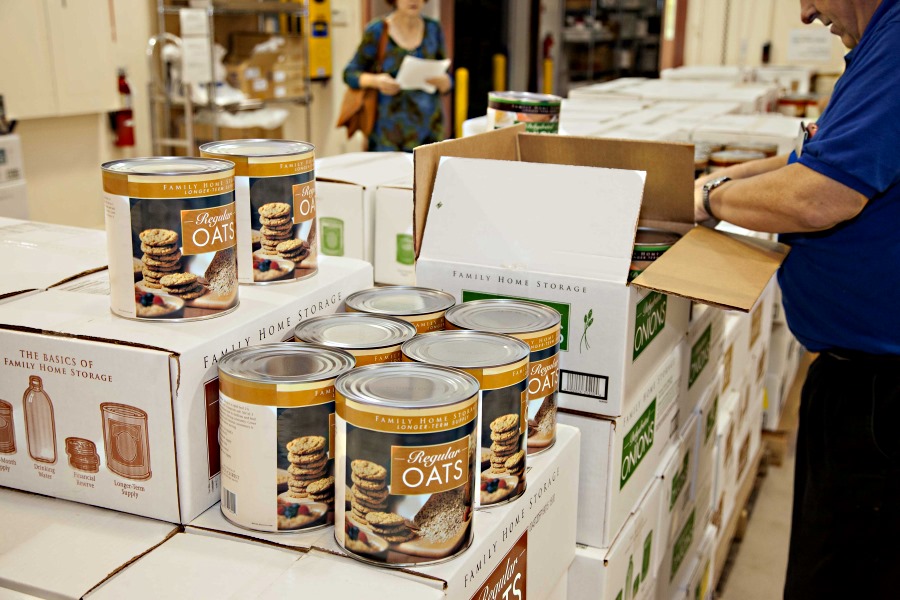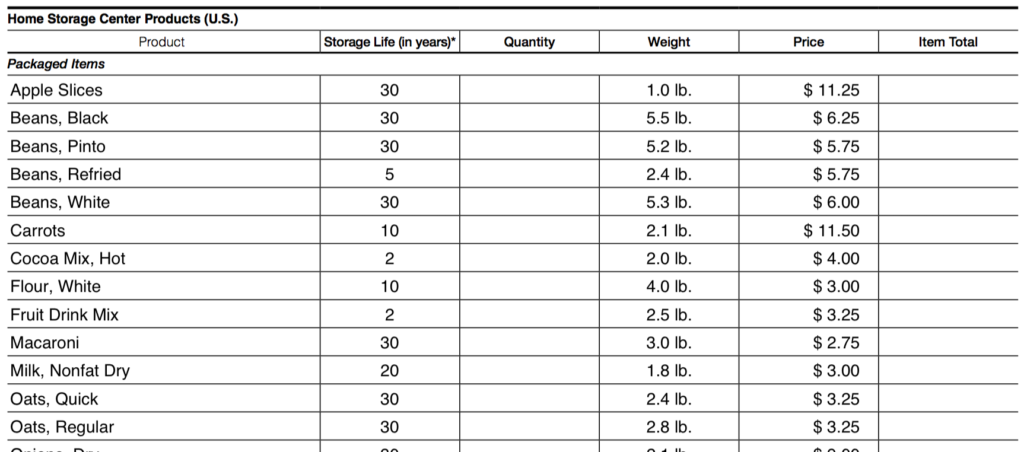If you’re just beginning your journey of preparations for doomsday, emergency survival, or infrastructure collapse, you’ll be shocked to see a year’s supply of freeze dried food or MREs will set you back several thousands of dollars. There has to be a cheaper way. Fortunately, there is: LDS Welfare Home Storage Centers.
About LDS Home Storage Centers
The best single-best resource for stocking your doomsday pantry is your local Latter Day Saints Home Storage Center. (They’re also sometimes called “Welfare Home Storage Centers”).
Here, they sell several canned foods in bulk, most of which have a 30 year shelf life, and for an extremely fair (cheap!) price.
Yes, it’s affiliated with the Mormon Church, but based on my experience shopping at a Home Storage Center, their mission isn’t to convert you. Educating the community on self-sufficiency and emergency preparedness is simply part of their ministry.
My Experience Buying Food in Bulk at a Home Storage Center
I live in a major city that has an LDS Storage Center on the outskirts. Awhile back, I summoned a friend to go with me. I was a little nervous — I didn’t want to get preached to, but what I’d read online made it sound like a fairly straightforward place.
The main entrance to the Home Center here is a casual market of sorts. I walked in, looked around, and didn’t see any #10 cans. I felt the eyes of all of the employees watching me. All I could see was some produce and a few small displays of bread and toothpaste. Confused, I asked the front desk worker where the canned goods were. They were confused for a moment, and finally figured out that I wanted to visit the back room.
A nice man escorted me to a small unassuming back room, gave me a shopping cart and a quick tour – which didn’t take long as it was one room. There were two shelving units with individual cans, and other items were displayed on top of pallets.
It took my friend and I close to an hour to sort through everything, discuss our emergency preparedness strategies, and how to divide our purchases. It would’ve been wise to have a plan ahead of time, but then again, there’s no guarantee of what they will have in stock.
The only other shopper was someone buying goods for a local homeless shelter, explaining it was priced far more reasonably than shopping at Kroger or standard supermarket.
Longevity of LDS Home Storage Canned Goods
The majority of products have a shelf life of 30 years. Others (dried milk, for example) have a shelf life of 10 or 5 years.

Cost of LDS Home Storage Canned Goods
The prices are VERY reasonable, especially if you’re used to buying cans of Mountain House freeze dried portions at $20 a pop.
The price varies according to the product. When buying in person, you can buy a can at a time or you can buy in bulk and get an entire box (six #10 cans).
Here are a few examples of cost:
- Six #10 cans of white rice: $39
- Six #10 cans of regular oats: $30
- Six #10 cans of dried onions: $50
You’ll be given form to track your purchases that looks like this. It’s a good idea to print and make up a list in advance, but keep in mind your Home Storage Center may not have everything on this list.

(Or click here to view the full order form.)
When to Go
Call before you go, the hours can be tricky! Our LDS Home Storage Center is only open a few days per month — on Tuesdays and the second Saturday. I went on a Tuesday afternoon and it was very quiet. From what the worker told me, Saturdays are a madhouse — that’s the day everyone visits from miles around. Since the order forms are filled out manually, it takes a long while checking out. Plus, they are more likely to run out of some items on Saturdays.
Buying Online
If you don’t live near an LDS Welfare Home Storage Center, you can buy some of their canned goods online. You can only buy in bulk and, in my very limited experience, the selection isn’t as good as in person — but several of these Home Storage Centers are only open a few days per month OR only allow LDS members.
Learn More
The LDS Home Storage Center is a GREAT resource and way to jumpstart emergency preparedness. They also have several additional resources to help guide you into managing long-term food storage, and making sure you have enough, depending on the size of your family. In my experience, they weren’t preachy; they were just kind and very helpful.
Visit the online store or find a Home Storage Welfare Center near you.
